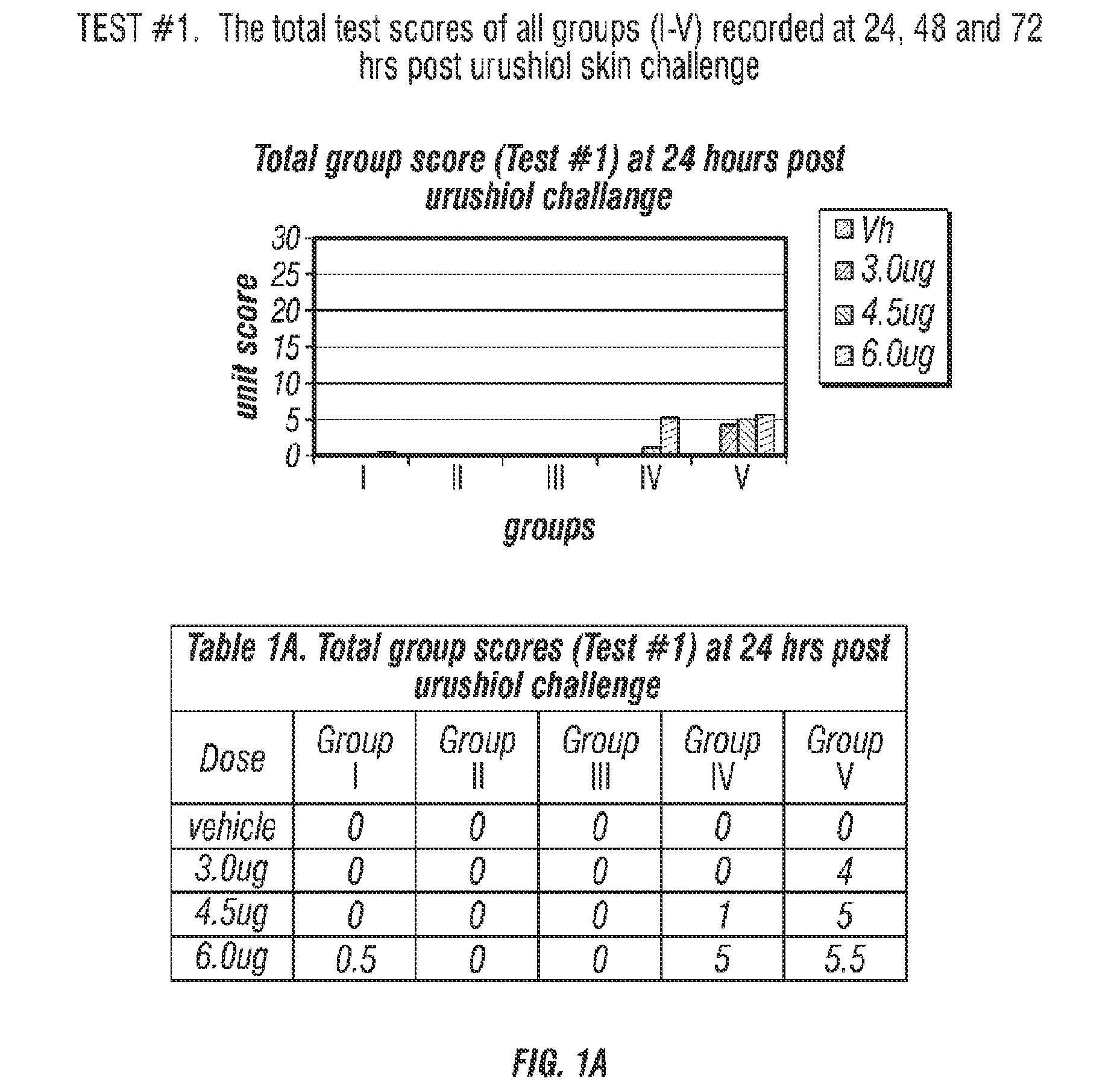Compositions for prevention/prophylactic treatment of poison ivy dermatitis
a technology of poison ivy and compositions, applied in the field of compositions for the prevention and/or prophylactic treatment of poison ivy dermatitis, can solve the problems of high risk of outdoor activities, significant medical expenses and worker's disability, and is difficult, if not impossible, to eliminate, so as to reduce the degree of sensitivity and eliminate the effect of sensitivity
- Summary
- Abstract
- Description
- Claims
- Application Information
AI Technical Summary
Benefits of technology
Problems solved by technology
Method used
Image
Examples
example 1
Synthesis of Penta or Hepta Decyl Catechol (PDC or HDC) (Procedure 1)
[0070]
[0071]To a solution of 2,3-dihydroxy benzaldehyde in anhydrous ethanol was added anhydrous K2CO3 along with catalytic amount of iodine and stirred at 5° C., while benzyl chloride was added drop wise.
[0072]The mixture was refluxed while stirring for 3 hours and then additional benzyl chloride was added and refluxed for another 2 hours.
[0073]The solvent was evaporated and the residue was partitioned between ether and water. The organic solution was washed with water and dried over sodium sulfate. All volatiles were evaporated on high vacuum and the product was obtained as light yellow solid material. The yield was quantitative.
[0074]
[0075]The tetradecyl Grignard reagent was prepared in the usual way from tetradecyl bromide, magnesium and trace of iodine in ether. To this solution at reflux was added 2,3 dibenzyloxy-benzaldehyde in ether. After the addition the mixture was refluxed for 4 hours, cooled, treated a...
example 2
Synthesis of Penta or Hepta Decyl Catechol (PDC or HDC) (Procedure 2)
[0078]
[0079]The tetradecyl Grignard reagent was prepared in the usual way from tetradecyl bromide (3.3 mmole), magnesium (3.5 mmole) and a trace of iodine in 3 L of ether. To this was added at reflux a solution of 2,3-dimethoxy-benzaldehyde (2.9 mmole) in 1 L of ether. After the addition, the mixture was refluxed for 4 hours, cooled, treated at 20° C. with 3 L of 12% HCl, the layers separated, and the organic layer washed twice with water and then once with brine. The ether was then rotaevaporated leaving a syrup which was dissolved in 2 L of MeOH. After cooling in an ice bath overnight the precipitated waxes were filtered. The crude product was isolated from the filtrate by rotaevaporation of all volatiles. The yield was quantitative.
[0080]
[0081]2,3-Dimethoxy-1-tetradecylbenzyl alcohol (1.7 mmole, crude) in 1.5 L of ethyl acetate was hydrogenated with 10 g 10% Pd / C catalyst and 10 mL of conc. H2SO4 at 200 PSI and ...
example 3
Synthesis of Penta or Hepta Decyl Catechol (PDC or HDC) (Procedure 3)
[0084]An alternate to the Grignard's reaction described in the above procedures, Wittig reaction was used to form an olefin as shown below followed by appropriate steps to yield the desired product.
[0085]
[0086]All the compounds formed were analyzed on HPLC for their purity (>99.5%).
PUM
| Property | Measurement | Unit |
|---|---|---|
| temperature | aaaaa | aaaaa |
| pH | aaaaa | aaaaa |
| volume | aaaaa | aaaaa |
Abstract
Description
Claims
Application Information
 Login to View More
Login to View More - R&D
- Intellectual Property
- Life Sciences
- Materials
- Tech Scout
- Unparalleled Data Quality
- Higher Quality Content
- 60% Fewer Hallucinations
Browse by: Latest US Patents, China's latest patents, Technical Efficacy Thesaurus, Application Domain, Technology Topic, Popular Technical Reports.
© 2025 PatSnap. All rights reserved.Legal|Privacy policy|Modern Slavery Act Transparency Statement|Sitemap|About US| Contact US: help@patsnap.com



